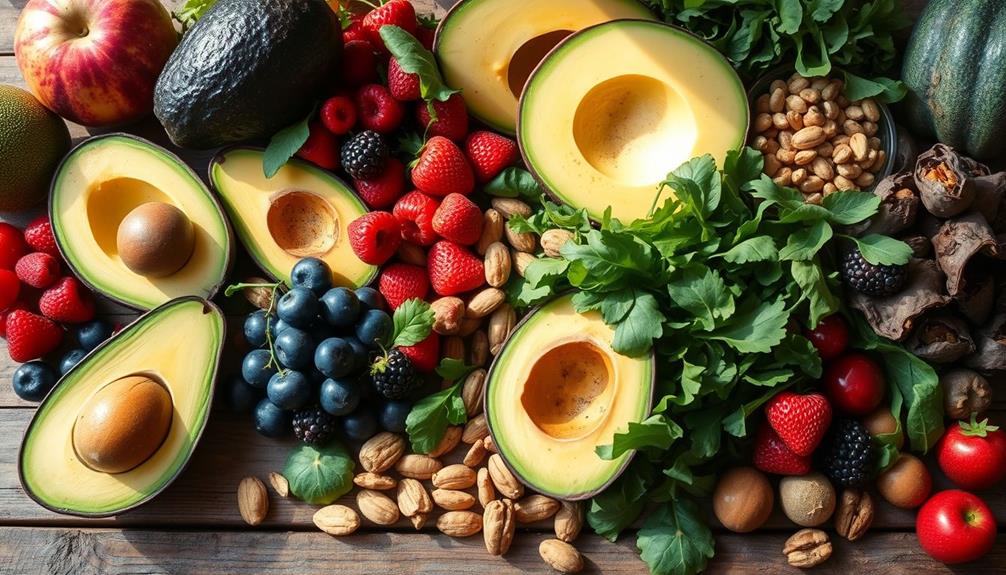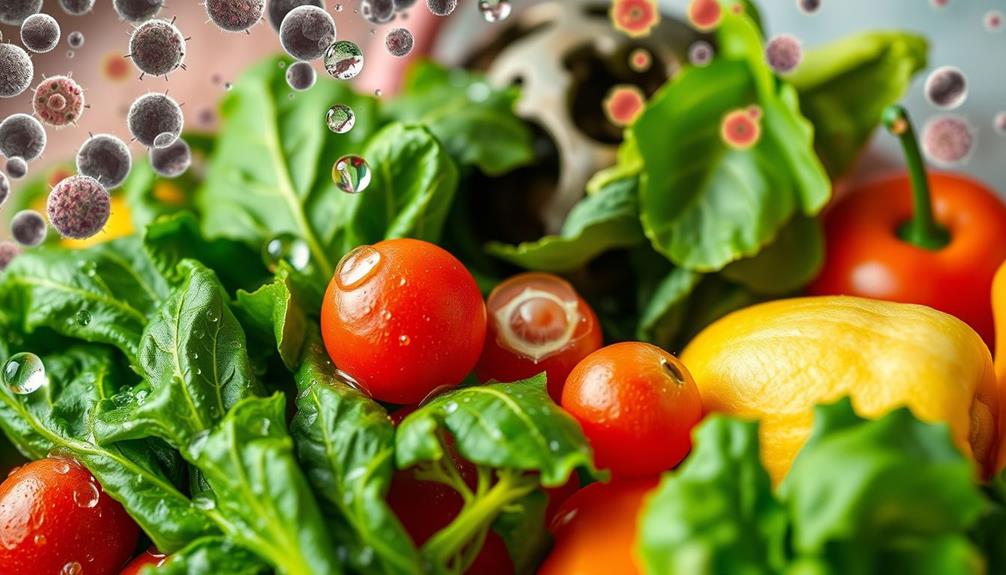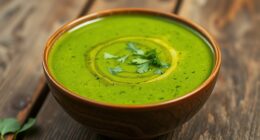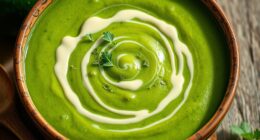Raw food looks vibrant and full of life, featuring an enticing mix of colorful fruits, crisp vegetables, nuts, seeds, and occasionally unprocessed dairy. Imagine a plate bursting with fresh greens, juicy tomatoes, and bright orange carrots, all drizzled with a zesty dressing. You might find a delightful breakfast smoothie made from ripe bananas and leafy spinach or a lunch salad with crunchy bell peppers and creamy avocado. Snack on raw nut bars or fresh fruits for a wholesome treat. As you explore this world, you'll discover more about its benefits and risks, enhancing your understanding of raw food. You may have questions about what can be considered raw food, such as, is peanut butter raw? The answer is that it depends on how it’s made. Some peanut butter is made from roasted peanuts, which would not be considered raw. However, there are also raw peanut butter options available that are made from unroasted peanuts, preserving their natural nutrients and enzymes. It’s important to do your research and read labels to ensure you’re choosing truly raw options if that’s important to you.
Key Takeaways
- Raw food primarily consists of uncooked fruits, vegetables, nuts, seeds, and some unprocessed dairy, emphasizing whole, natural ingredients.
- Vibrant colors and textures characterize raw food dishes, showcasing the freshness of ingredients like leafy greens, ripe fruits, and crunchy nuts.
- Popular raw food preparations include smoothies, salads, spiralized vegetable noodles, and energy balls made from dates and nuts.
- Techniques like soaking, sprouting, and dehydrating enhance the digestibility and nutritional value of raw foods, making them more flavorful and nutritious.
- Raw food meals often highlight seasonal produce, creating visually appealing and nutritious plates that prioritize natural flavors and textures.
Definition of Raw Food
When you think about raw food, it primarily refers to uncooked items that haven't been heated above 48°C (115°F). This approach to eating emphasizes whole foods like fruits, vegetables, nuts, seeds, and some dairy products. By sticking to these uncooked options, you're aiming to preserve the nutritional value of the ingredients, including their natural enzymes and nutrients that can be diminished through cooking.
Additionally, incorporating fresh juices, such as celery juice, can enhance your raw food diet with their high levels of antioxidants and anti-inflammatory properties. The raw diet excludes refined and chemically processed items, focusing instead on the freshness and integrity of the food you consume. Advocates of raw food believe that this way of eating can offer significant health benefits, such as improved digestion and increased energy levels. By opting for raw fruits and vegetables, you're also enjoying a wider array of vital vitamins and minerals.
However, it's important to be aware of the risks associated with raw food, particularly concerning foodborne illnesses like salmonella and E. coli. These risks often arise from raw animal products or contaminated produce.
As a result, while the raw diet can be nutritious and beneficial, it's essential to practice safe food handling to minimize these potential dangers.
Popularity of Raw Food Movement
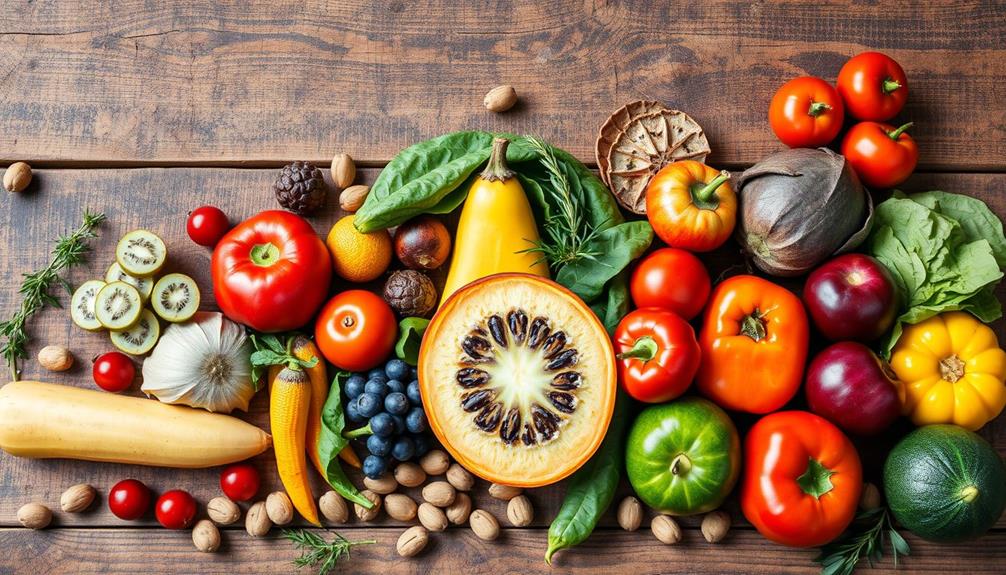
The raw food movement has surged in popularity as more people seek healthier eating habits and natural lifestyles. This trend is particularly popular among those who want to improve their health through raw food diets, which focus on unprocessed, whole foods.
The benefits of raw food, such as enhanced nutrient absorption and increased energy levels, have captivated many individuals looking to optimize their diets. Social media platforms and influencers have greatly contributed to this movement, showcasing vibrant raw meals and inspiring followers to adopt similar lifestyles.
As you explore this movement, you'll notice that the availability of raw food products has expanded in markets, making it easier for you to find fresh ingredients and prepared options.
However, it's important to be aware of ongoing debates surrounding raw diets. While many people who follow these diets report positive health outcomes, there are also concerns about potential nutritional deficiencies. Ensuring a balanced nutrient intake is critical for those embracing this lifestyle, especially when reflecting on the safety of raw food diets.
These discussions fuel interest in the raw food movement, prompting you to weigh both the benefits and risks of incorporating more raw foods into your diet.
Ultimately, the growing popularity reflects a broader desire for health and wellness, pushing individuals to rethink their dietary choices and embrace a more natural approach to eating.
Health Benefits of Raw Foods
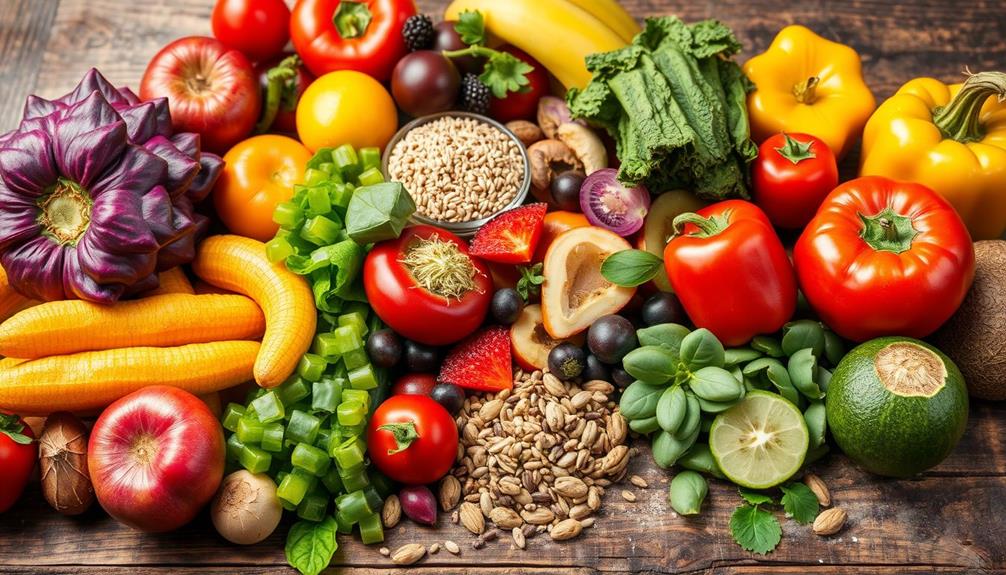
Eating raw foods can greatly boost your nutrient intake, as these foods retain more vitamins and minerals compared to their cooked counterparts.
Incorporating raw fruits and vegetables may also provide health benefits such as improved digestive health and lower uric acid levels, which can be beneficial for those managing conditions like gout foods beneficial for managing gout symptoms.
You might also find that a raw diet supports weight loss by keeping calorie counts lower while providing plenty of fiber to keep you full.
Plus, the natural enzymes found in raw fruits and vegetables can enhance your digestive health, making you feel even better overall.
Nutrient Preservation Benefits
Raw food diets highlight the nutrient preservation benefits that come from consuming unprocessed fruits and vegetables. When you choose raw foods, you're maximizing your intake of essential nutrients and enzymes that cooking often destroys. For instance, vitamin C and several B vitamins remain intact in raw produce, enhancing their nutritional value.
Additionally, incorporating a variety of raw foods can be a form of financial investment in your health, as they often lead to better overall well-being and potentially lower medical costs in the long run.
Incorporating a variety of raw fruits and vegetables into your diet can greatly improve your health. These foods are naturally high in fiber, which aids digestion and helps you feel full longer, supporting your weight loss efforts without the empty calories found in processed foods.
Additionally, the antioxidants and vitamins present in raw foods may lower your risk of chronic diseases, including heart disease and certain cancers.
Weight Loss Support
Choosing a raw food diet not only preserves nutrients but also supports weight loss effectively. Raw foods are typically low in calories while being high in fiber, helping you feel full longer. This increased satiety reduces your overall calorie intake, making it easier to shed those extra pounds.
The high nutrient density of raw fruits and vegetables boosts your metabolism, promoting fat loss without the unhealthy fats and sugars found in processed foods. Additionally, incorporating more whole foods and low-glycemic options can further enhance your weight loss journey, as seen in managing insulin resistance.
Studies show that people on a raw food diet often experience a reduction in body fat and lower triglyceride levels, enhancing cardiovascular health. By incorporating more fresh produce into your meals, you're likely to develop healthier eating habits, which can curb cravings for processed foods and added sugars—two major culprits in weight gain.
Additionally, a raw food diet doesn't just support weight loss; it can improve your skin health and increase your energy levels, contributing to your overall health.
With raw foods, you're not just changing your diet; you're adopting a lifestyle that emphasizes wellness and health. Embrace the benefits of raw foods, and watch as you transform your approach to health and weight management.
Improved Digestive Health
One of the standout benefits of a raw food diet is its positive impact on digestive health. By incorporating more raw foods, you're likely to consume higher fiber content from fresh fruits and vegetables. This boost in fiber promotes regular bowel movements and helps prevent constipation, making your digestive system function more smoothly.
Additionally, understanding the importance of end-of-life care options can provide insights into holistic approaches to health, including dietary choices that support overall well-being.
Raw foods also retain natural enzymes that assist in digestion, which may enhance nutrient absorption in your gastrointestinal tract. Plus, the high water content found in many raw fruits and vegetables keeps your digestive system hydrated, further supporting overall digestive function.
If you explore fermented raw foods like kimchee and sauerkraut, you'll introduce beneficial probiotics into your diet. These probiotics can greatly improve gut health, enhancing your digestive experience. Many individuals report improved digestion and reduced bloating after altering to a raw food diet, often due to the elimination of processed foods and additives that can disrupt normal digestion.
With these combined effects, a raw food diet can be a game-changer for your digestive health, helping you feel lighter, more energetic, and more comfortable in your body.
Risks Associated With Raw Food
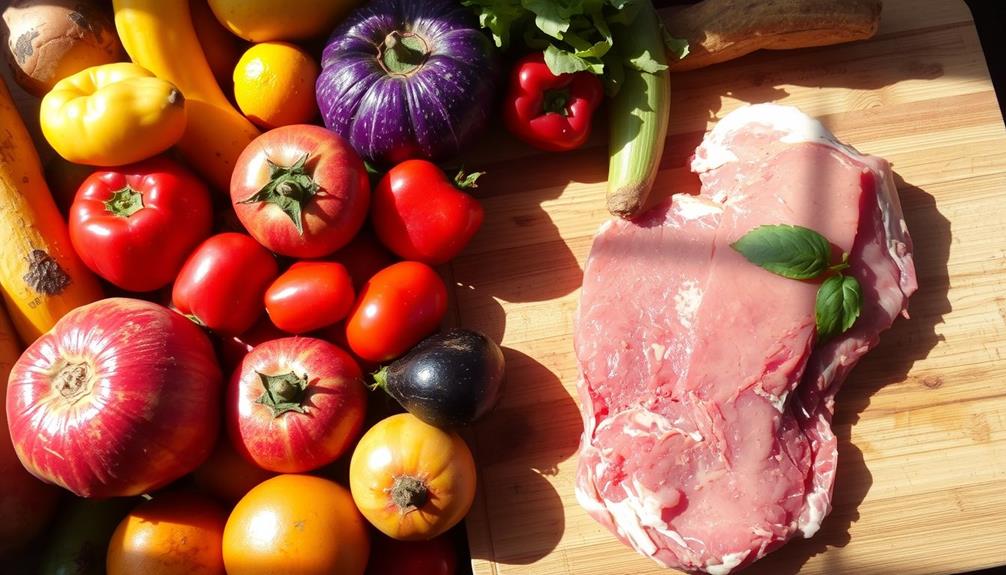
When you choose a raw food diet, you might face significant risks, especially from foodborne illnesses linked to raw produce and unprocessed animal products.
Additionally, certain essential oils, such as eucalyptus oil, can be beneficial for overall health but should be used with caution to avoid any adverse effects.
It's vital to be aware that certain raw foods can lead to nutritional deficiencies, leaving you short on essential nutrients.
Understanding these risks can help you make informed choices about your diet.
Foodborne Illness Risks
Eating raw foods can be a delightful experience, but it's essential to be aware of the significant risks of foodborne illnesses that come with them.
Consuming raw produce, unpasteurized dairy, and undercooked animal products can expose you to harmful pathogens like Salmonella and E. coli, leading to severe gastrointestinal issues.
Proper preparation and handling of raw ingredients are important to minimize these risks, just as maintaining a clean environment is critical for pet care, such as ensuring a healthy habitat for your hamster care and costs.
To stay safe, consider these important tips:
- Thoroughly wash all raw produce to reduce contamination risks.
- Avoid unpasteurized dairy products, as they can harbor dangerous bacteria.
- Steer clear of undercooked animal products, including meat and eggs, to prevent illness.
- Practice good food safety habits, especially when preparing sprouts and raw juices.
Nutritional Deficiencies Concerns
While enjoying the fresh taste of raw foods can be appealing, it's important to recognize the potential for nutritional deficiencies that may arise from such diets. Many raw food enthusiasts exclude animal products, which can lead to inadequate intake of essential nutrients like protein, vitamin B12, iron, calcium, and omega-3 fatty acids.
Without a diverse food variety, your body may struggle to get what it needs. Additionally, maintaining a balanced diet is essential for overall health, as highlighted by the emphasis on environmental interactions in key domains of development.
Research indicates that long-term raw food vegetarians might experience lower bone mass and heightened risks related to high homocysteine levels, which could impact your cardiovascular health.
Additionally, cooking can improve nutrient absorption, meaning raw diets may reduce the bioavailability of critical vitamins and minerals.
To mitigate these risks, careful planning is necessary. You may need to incorporate strategic food combinations or consider supplementation to meet your daily nutritional needs.
Also, be mindful that increasing your intake of raw, fiber-rich foods might lead to digestive issues like gas and cramping if done too quickly. Balancing your diet is key to enjoying the benefits of raw foods without compromising your health.
Types of Raw Food Diets
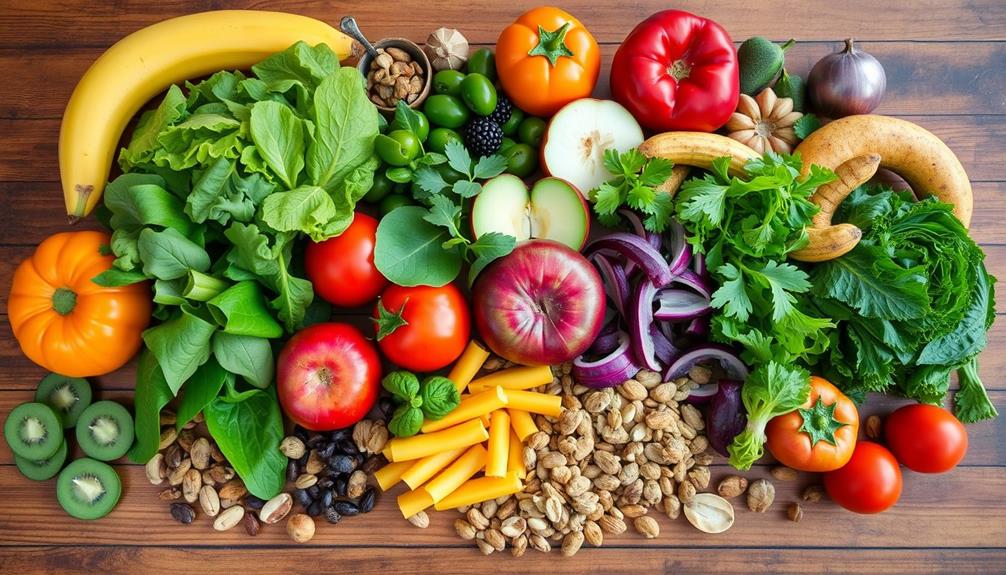
What types of raw food diets are out there? When diving into the world of raw food, you'll find several options, each with unique characteristics.
For instance, many people enjoy the idea of maintaining a raw vegan diet for its potential health benefits, such as increased energy and improved digestion.
Here are the most common types:
- Raw Vegan Diet: This diet excludes all animal products, focusing solely on plant-based foods like fruits, vegetables, nuts, and seeds.
- Raw Vegetarian Diet: This includes plant-based foods along with unprocessed dairy products and raw eggs, which can provide a broader range of nutrients.
- Raw Omnivorous Diet: This incorporates both plant-based foods and raw animal products, including raw or dried meat, but it's less common due to food safety concerns.
- Variability in Raw Diets: Some individuals may allow minimal cooked foods while others strictly adhere to a fully raw regimen.
Regardless of which type you choose, you'll enjoy the benefits of uncooked foods and their high nutrient content.
Just remember to prioritize food safety, especially if you're including any animal products.
Each diet has its own advantages, so consider what aligns best with your lifestyle and health goals.
Additionally, learning about the health benefits of different food choices can help you make informed decisions.
Food Preparation Techniques
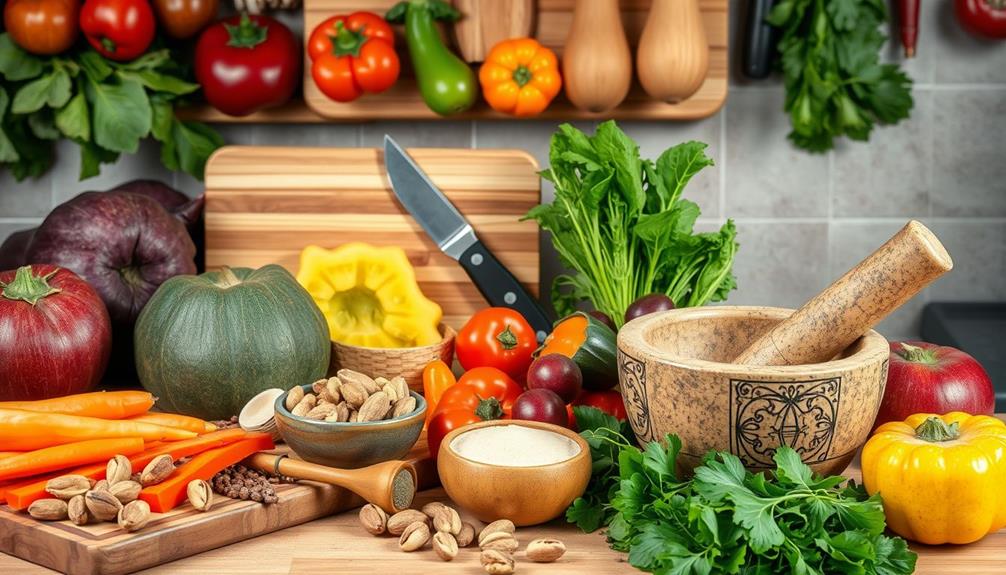
When you prepare raw foods, soaking and sprouting are key techniques that enhance digestibility and boost nutrient absorption.
You can also extend the shelf life of your snacks by dehydrating fruits and veggies at low temperatures.
Plus, juicing and blending make it easy to enjoy a variety of flavors while keeping all the nutrients intact.
Soaking and Sprouting Techniques
Soaking and sprouting techniques transform raw foods into nutrient-rich powerhouses that enhance your diet. By immersing beans, grains, or nuts in water for several hours, soaking improves digestibility and enhances nutrient absorption. It also removes enzyme inhibitors, making nutrients more bioavailable and reducing potential digestive discomfort.
Sprouting involves germinating seeds, grains, or legumes by soaking them and allowing them to grow in a moist environment. This process increases their nutrient content, making sprouted foods often more nutritious than their unsprouted counterparts.
Here are some benefits of soaking and sprouting:
- Improved Texture: Soaked nuts and seeds yield a creamier texture, perfect for nut milks and raw desserts.
- Enhanced Nutrients: Sprouting boosts levels of vitamins and minerals, making your meals more nourishing.
- Better Digestibility: Both techniques help you digest foods more easily, reducing bloating or discomfort.
- Versatile Uses: You can incorporate soaked or sprouted foods into salads, smoothies, or snacks.
Incorporating soaking and sprouting into your raw food preparation can elevate your meals and maximize the nutrients you consume.
Dehydrating and Juicing Methods
After mastering soaking and sprouting, you can further enhance your raw food experience with dehydrating and juicing methods. Dehydrating involves removing moisture from raw fruits and vegetables at low temperatures (below 118°F), preserving nutrients and enhancing flavors. You can create delicious fruit leathers, vegetable chips, and dried herbs while ensuring they retain their nutritional value.
On the other hand, juicing extracts liquid from raw fruits and veggies, allowing for concentrated nutrient intake. However, be mindful that juicing can lead to a loss of fiber. Opt for cold-pressed juicing techniques, which minimize heat exposure, helping to retain enzymes and nutrients.
Here's a quick comparison of these two methods:
| Method | Benefits |
|---|---|
| Dehydrating | Enhances shelf life and flavor; retains nutrients |
| Juicing | Provides concentrated nutrient intake; minimizes waste |
Both methods demand attention to food safety practices. Always wash raw produce thoroughly and store your dehydrated or juiced products properly to reduce the risk of foodborne illnesses. By using dehydrating and juicing, you can enjoy a diverse and nutrient-rich raw food diet.
Nutritional Considerations
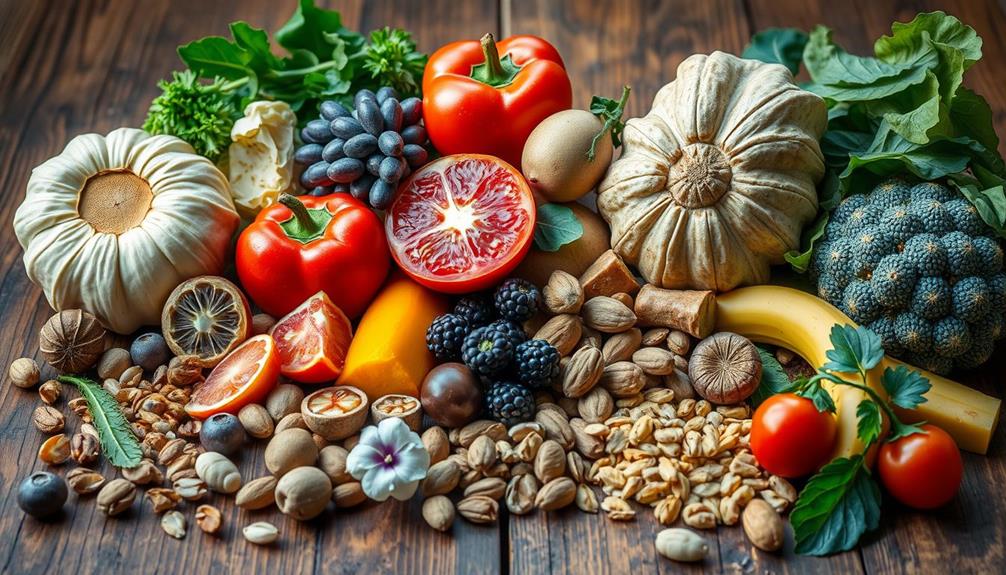
Adopting a raw food diet can bring a wealth of nutrients and fiber into your meals, primarily from fresh fruits, vegetables, nuts, seeds, and sprouted grains.
However, it's important to evaluate your nutritional needs carefully. While this diet can improve digestion and overall health, it does come with risks of nutritional deficiencies.
To maintain a balanced raw food diet, pay attention to these significant nutrients:
- Vitamin B12: This is mainly found in animal products and is important for nerve function.
- Iron: Plant-based iron is less absorbable, so you may need to include sources like spinach and lentils.
- Calcium: Essential for bone health, think about raw kale and almonds to boost your intake.
- Omega-3 fatty acids: Found in flaxseeds and walnuts, these are critical for heart health.
Without careful planning and possibly supplementation, you might face imbalances over time.
Long-term adherence to a raw food diet can lead to lower bone mass and health issues if these nutrients aren't adequately managed.
Stay informed to thrive on your raw food journey!
Pros and Cons Overview

Exploring the raw food diet reveals both appealing benefits and notable drawbacks. On the plus side, you might experience weight loss thanks to lower calorie consumption. The high fiber content can improve your digestion and contribute to a reduced risk of chronic diseases, as you consume mostly fresh fruits, vegetables, nuts, and seeds.
However, there are also significant cons to take into account. Following a raw food diet can lead to nutrient deficiencies, particularly in protein and vitamin B12, which are vital for your overall health. You may also struggle to maintain adequate calorie intake, making it tough to meet your energy needs.
Food safety concerns are another issue; consuming raw animal products and certain vegetables can increase the risk of foodborne illnesses. Additionally, adhering to a raw food diet can feel socially restrictive, especially during gatherings where cooked food is prevalent.
You'll find that meal preparation can be time-consuming and requires careful planning to guarantee you're meeting your nutritional needs. Weighing these pros and cons can help you decide if the raw food diet aligns with your lifestyle and health goals.
Sample Raw Food Menus
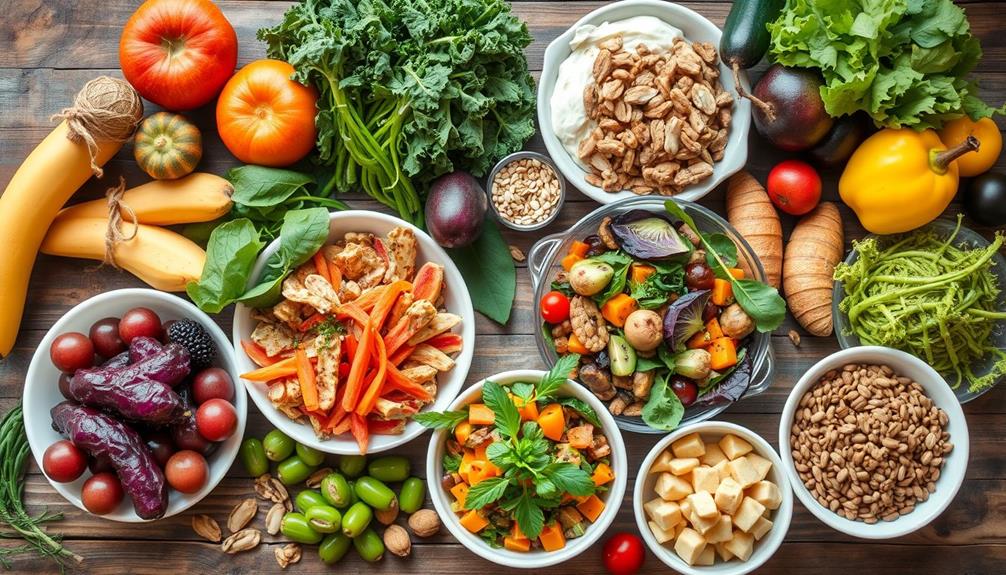
A raw food diet can be deliciously varied, offering plenty of options for meals throughout the day. For breakfast, you can whip up a smoothie packed with fresh fruits, leafy greens, and nut milk, giving you a nutrient-rich start.
Lunchtime might feature a colorful salad filled with raw vegetables, topped with nuts and seeds for essential vitamins and healthy fats.
Here's a sample menu to inspire you:
- Breakfast: Smoothie with fresh fruits, leafy greens, and nut milk
- Lunch: Colorful salad with raw vegetables, nuts, and seeds
- Snack: Fresh fruits, raw nut bars, or dehydrated veggie chips
- Dinner: Spiralized zucchini noodles with homemade raw tomato sauce
For dessert, indulge in raw cacao energy balls made from dates, nuts, and cacao powder. They're perfect for satisfying your sweet cravings while sticking to your raw food guidelines.
Tips for Beginners
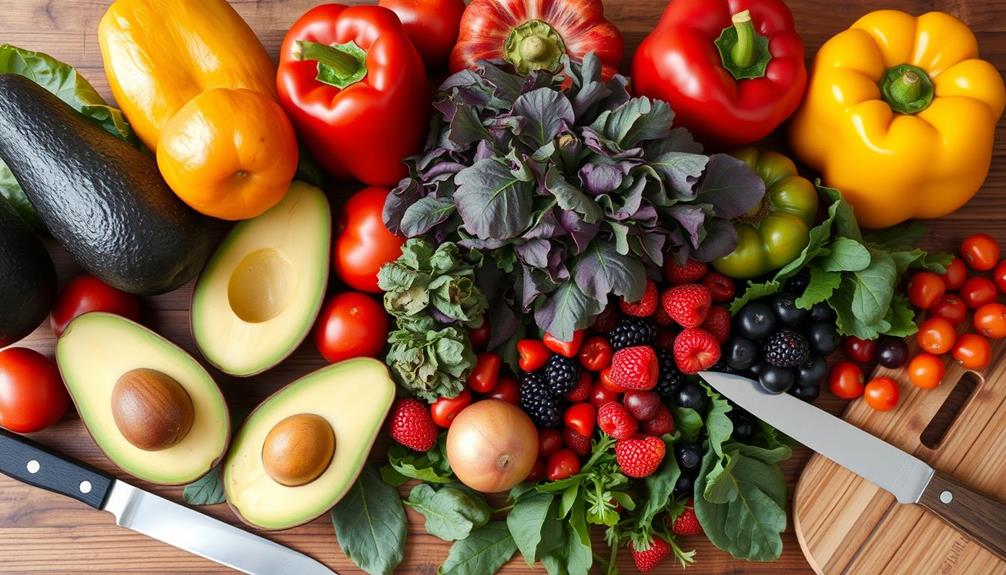
Starting a raw food diet can feel overwhelming, but you can ease into it with a few simple tips. Begin with simple recipes like smoothies and salads to gradually incorporate raw foods into your diet. This approach helps you shift smoothly and keeps things manageable.
Focus on using seasonal produce, as it offers better flavor and nutrition, enhancing your overall eating experience.
Investing in a high-quality blender or food processor is essential. These tools will make preparing many raw food dishes much easier and more enjoyable.
As you begin on your raw food journey, consider joining online communities or local groups. Sharing recipes and experiences provides support and inspiration, making the process more fun.
It's important to gradually increase your raw food intake. Allowing your body time to adjust can help minimize any digestive discomfort you might experience during this shift.
Frequently Asked Questions
What Is the Overview of Raw Food Diet?
The raw food diet emphasizes unprocessed, whole foods, focusing on fruits, vegetables, nuts, and seeds. You'll experience benefits like increased energy and weight loss, but careful planning's essential to avoid nutrient deficiencies.
What Is Raw Food Explanation?
Did you know that about 1 in 5 Americans now follow a raw food diet? Raw food means unprocessed, uncooked items like fruits, veggies, nuts, and seeds, focusing on preserving nutrients and enzymes for ideal health.
What Does a Balanced Raw Diet Look Like?
A balanced raw diet includes fresh fruits, vegetables, nuts, seeds, and sprouted grains, ensuring you get essential nutrients. Don't forget protein sources and fermented foods for gut health, while planning for B12 and omega-3 intake.
What Are 10 Raw Foods?
When exploring raw foods, you'll find fresh fruits like apples and bananas, crunchy vegetables such as carrots and bell peppers, nuts like almonds, seeds like chia, and sprouted grains including quinoa. Enjoy their natural goodness!
Conclusion
To sum up, embracing a raw food diet can be a vibrant journey for your health. Did you know that studies show people who consume a diet rich in raw foods can increase their intake of vitamins and minerals by up to 30%? While the benefits are enticing, it's important to stay mindful of the potential risks. If you're ready to plunge into this lifestyle, remember to start slow and experiment with different recipes to find what works for you!

